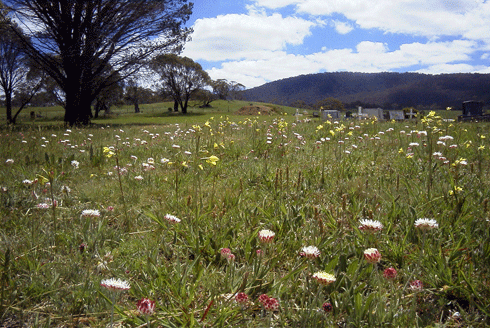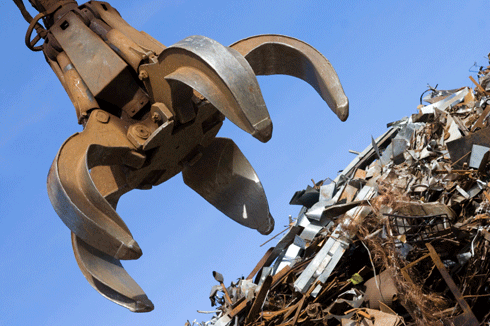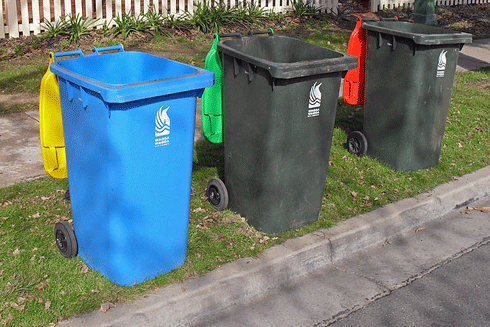
|
Published: 21 January 2013
Rocks and paddock trees: biodiversity’s unlikely allies
In Australia’s high-rainfall zone, which encompasses Australia’s most profitable farming areas, land uses are changing rapidly. How do they threaten biodiversity, and how can they be managed?

|
|
Wildflowers in a native grassland in Moonbah cemetery, southern New South Wales. Credit:
Linda Broadhurst, CSIRO
|
Australia’s high-rainfall zone (HRZ) stretches from southern Queensland into South Australia, in a band that hugs the coast and extends some way inland of the Great Divide. Another pocket is found in south?western Australia.
Drive west from Sydney or Canberra, cross the Great Dividing Range, and in the foothills on the inland side you find yourself in country that has traditionally been dominated by grazing.
Continue further west, and the landscape flattens out, the climate becomes drier and cropping enters the farming mix.
Historically, cropping has been confined to the drier parts of the HRZ, due to the susceptibility of wheat to pathogens such as rust stripe. A significant proportion of grazing in these areas has been on native pastures: a low-intensity form of land use. In contrast, ‘improved pasture’ grazing involves sowing exotic pasture species and fertilisation, and typically allows for a higher stocking rate. Cropping can be rotated with grazing (i.e. mixed farming), so that soil fertility depleted during the cropping cycle is partially restored during the grazing phase.
But times are changing, with significant consequences for Australian biodiversity. A recent CSIRO report – Land use change and biodiversity in the High Rainfall Cropping Zone (HRZ), funded by the Grains Research and Development Corporation – confirms what many agricultural industry players here and overseas have been observing for a while: a shift to more intensive land use.
Report co-author, Saul Cunningham of CSIRO’s Ecosystem Sciences, says the data show there are actually two changes going on in the landscape: both of which are forms of ‘what we could call land-use intensification’.
‘One trend has been for what was native-grass grazing to be increasingly replaced by improved pasture [fertilised and seeded pastures],’ he says. ‘At the same time, [grazing is] being replaced by cropping.’
These two changes can have a significant impact on biodiversity. Grasslands tend to be highly diverse ecological communities, and many grassy ecosystems are either endangered or threatened under state and federal legislation.
‘If you think about the cropping case – if you put in a crop, you turn whatever was in the ground layer into one species, so that’s a big change to the ecology of the landscape,’ says Dr Cunningham.
‘And, it’s very hard to go back – although in practice, it’s probably more a series of steps over time: native grasslands, some improved pasture, more improved pasture, then crop.’

|
|
Remnant native woodland in the high rainfall zone. Credit:
Philip Barton
|
Among the biodiversity assets being lost are scattered paddock trees – think of the familiar Australian rural landscape of grazing lands with a smattering of old eucalypts. While it is illegal and therefore unusual for farmers to remove these trees, when cropping begins around and under them, there is little opportunity for the trees to regenerate.
‘They can be at risk from increased fertilisation, root disturbance, and insecticide drift. It gets harder and harder for those trees to survive in that new land use,’ says Dr Cunningham.
Other biodiversity assets include rocky outcrops. To farmers intending to crop, they often represent shallow soil and obstructions to machinery; but, a range of plants and animals use these outcrops.
Paul Ryan is a consultant who helps natural resource agencies, such as catchment management authorities, plan for change such as climate change and population growth.
‘The shift from low-intensity land use [such as grazing of native pastures] to cropping – and it tends now to be high-intensity cropping – means you get a dramatic decrease in biodiversity in a relatively short space of time,’ says Mr Ryan. ‘On my family’s farm, for example, it drove down biodiversity dramatically quickly. We lost a large number of fairly common native species off the property in a short space of time – less than 10 years.’
According to Mr Ryan, large areas of the landscape are subjected to these pressures, and the loss of biodiversity may well end up being comparable to the drops in biodiversity that followed the first wave of land-clearing for sheep grazing in the nineteenth century.
‘Now you’re getting this second wave. And this time, you lose not only biodiversity, but it changes the soil, the microtopography.’
Among the drivers of land-use intensification identified in the CSIRO report are farmers taking up opportunities created by new wheat varieties resistant to pathogens associated with higher rainfall areas.
Mr Ryan also points to declining terms of trade for traditional agriculture and the insecurity associated with fluctuating livestock prices.
‘The rising costs of fertiliser, labour, machinery, and chemicals means that most landholders only have a couple of options if they want to continue to make a reasonable living above CPI: to get more intensive, or to get bigger.
‘In reality, a lot do both: either expand or farm smarter, which means more inputs and use of available technology to increase productivity.
‘Grazing, whether sheep or cattle, has been all over the place. Ewes have gone from being $250 per head to $100 per head, and lambs from $160 per head to $60–70 per head, which is not enough to make a living from. Cropping fluctuates as well, but lots of people see cropping as more secure.’
Younger farmers are leading the move towards higher-intensity land use. Linda Broadhurst, another co-author of the CSIRO report, believes younger farmers are more prepared to take a risk and be more innovative.
‘Farmers generally express a desire to keep biodiversity in their landscapes,’ Dr Broadhurst says. ‘They are not trying to work against biodiversity; they need information and awareness about the features that support biodiversity and keep it in the landscape.’
Griffith farmer Michael Pfitzner and his wife Larissa farm the plains between Griffith and Hillston in mid-New South Wales. Over the past five years, they have moved from a mixed farming enterprise to 100 per cent cropping.
‘I think most farmers are interested in conservation. We certainly want to leave the place in a better condition than what we walked into,’ says Mr Pfitzner.
The couple have destocked and ‘locked up’ a number of timber lots on their land. Trees include remnant box gums and mallee, among planted pine and other planted native species. In 2012, they won a New South Wales Conservation Farmer of the Year award, presented by the Conservation Agriculture and No-Till Farming Association.
‘The land title now includes those locked up areas – they now can’t be used for anything else, even when the land is sold,’ says Mr Pfitzner. ‘Having those areas locked up and destocked means that there are more native grasses in those areas. We also keep introduced predators such as foxes and rabbits down to look after the native species.’
Mr Pfitzner says he did remove some scattered paddock trees to support his controlled-traffic, zero-till, full-stubble-retention cropping strategy. This was made possible by developing a property vegetation plan in conjunction with the regional catchment management authority, which permitted tree removal in exchange for tree-planting offsets.
The aim of a controlled-traffic cropping system is to improve soils by avoiding random heavy machinery traffic.
‘We retain stubble residues to give us better infiltration rate for moisture and reduce compaction across paddocks,’ adds Mr Pfitzner. ‘We also grow different crop species to improve soil structure and nutrition with minimal disturbance.’

|
|
Farmers can encourage biodiversity by allowing paddock trees to coexist with crops. Credit:
CSIRO
|
The authors of the CSIRO report would like to see farmers retain isolated paddock trees, which are key to encouraging biodiversity in the landscape.
‘You can crop around them, and people do,’ says Dr Cunningham. ‘It just takes some planning. It’s not always popular, in the sense that it might be easier to run your harvester in a straight line.’
‘While preserving these old trees, the next challenge is to find places in the landscape where new trees can regenerate, to maintain the scattered tree landscape into the long term.
‘There is still fantastic biodiversity in our landscape, which Australians value. We can still produce crops and manage landscapes so that we can have production and biodiversity. If we recognise the features in the landscape that biodiversity depends on, such as rocky outcrops, remnant forest woodlands, and wildflowers, we can manage the whole landscape with these features in mind.’
Retaining paddock trees also has the advantage of maintaining diverse land-use options. The trees that are in the way of the harvester one year are the same trees that could provide shelter for stock a few years later if the farmer wishes to return to grazing, or rotate grazing with cropping.
The economics of conservation farming are a challenge. However, this pro-biodiversity attitude gives natural resource professionals and government agencies scope to work with farmers and provide options.
Mr Ryan believes that the kind of short-term incentive schemes traditionally available to farmers to conserve on-farm biodiversity are not adequate to cope with the scale of change currently occurring. Ecological processes, he points out, are much longer and slower than the typical three-year electoral cycle that shapes incentive schemes.
‘I don’t see a massive benefit from small-scale incentive schemes. It has to be on a massive scale: thousands and thousands of square kilometres that need vegetation maintained.
‘There is a temporal dimension as well. There is the short-term impact of the loss of the trees, and the long-term change of losing the next generation of trees, if they’re not regenerating in the long term or we’re not putting trees in for secure long-term outcomes. These scattered trees probably live for 300 years in total. We need to think in at least decadal timescales.’





